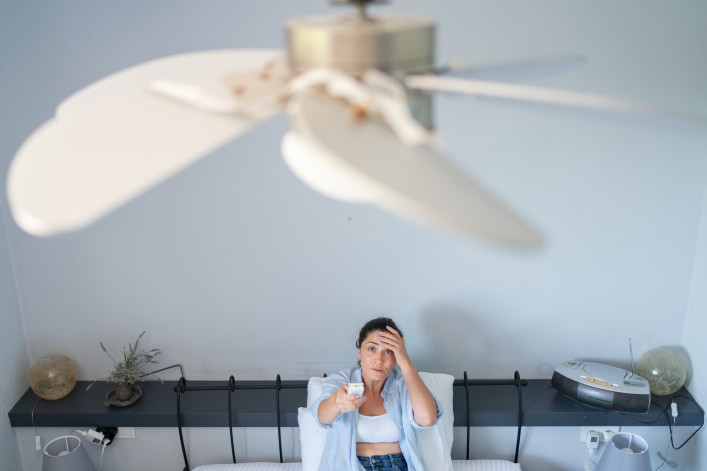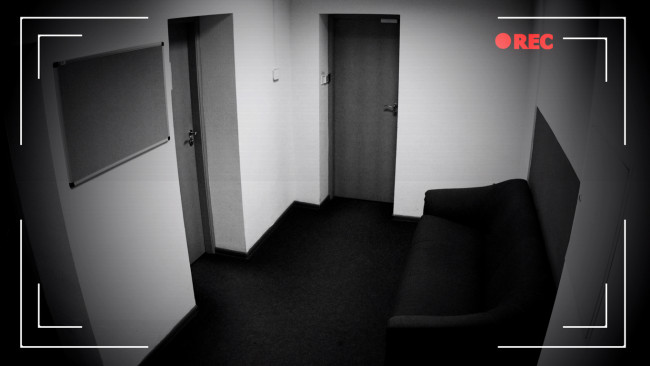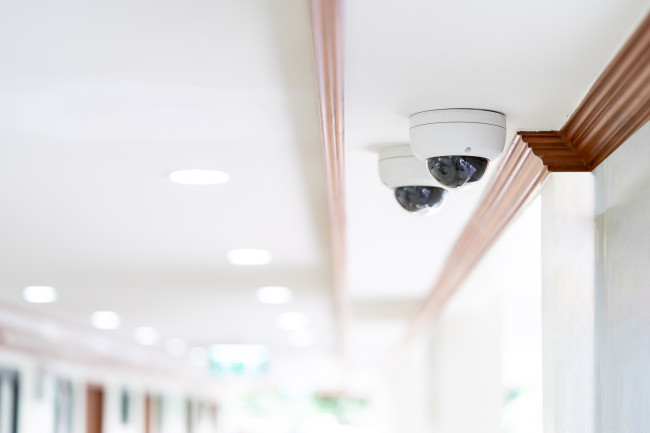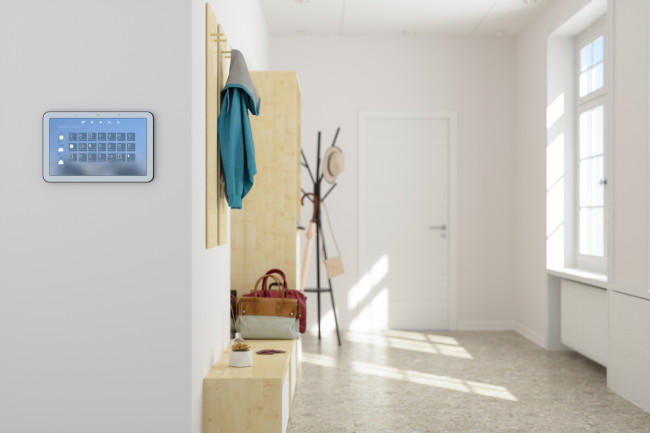How to find a hidden camera planted by your landlord, Airbnb host, or another creep
- 'The number of requests for sweeps continues to increase, as is the number of hidden cameras we are finding'
- Focus on bedrooms, bathrooms, and anywhere else you get undressed, then consider the angle of the camera
- DIY options include lens-detecting apps and multi-bug detectors, or hire a pro—the cost starts around $1,750

Tiny cameras with pinhole lenses can be hidden anywhere, including overhead lighting or ceiling fans.
iStock
Renting a new apartment? It may be scary to contemplate, but there are many places for someone to plant a hidden camera and secretly record your every move for their own sick pleasure. There’s also been a rash of spy cam incidents at Airbnb rentals worldwide.
That's despite Airbnb and VRBO policies prohibiting vacation homeowners from installing indoor security cameras to monitor guests. A 2024 report by smart home technology company Vivint shows that one in 12 owners confess to still using them, and one in 20 renters discovered a hidden camera during their stay. Yikes.
“Hidden cameras are an epidemic in New York City, and people don’t even realize how bad it is,” says Jimmie Mesis, founder and director of USA Bug Sweeps, which specializes in finding hidden cameras in NYC apartments and conducts more than 350 sweeps yearly.
He previously told Brick that he was busier than ever during the height of the pandemic—even when NYC was locked down. But in 2024, “people are still spying on each other," he says. "The number of requests for sweeps continues to increase, as is the number of hidden cameras we are finding."
Typical cases involve a young, single woman renting an apartment, but any type of housing is susceptible. The places where you can hide a bug are seemingly endless—such as vents, ceiling fans, and fire detectors. “No one is free from being watched,” he says.
Here’s the advice Mesis gives for how to detect a spy cam and what to do if you find one.
[Editor’s Note: A previous version of this article was published in September 2023. We are presenting it with updated information for September 2024.]
How can I tell if I am being spied on?
Start by being aware of your surroundings, Mesis says. Take inventory—ideally with photos—of your belongings and pay attention to where everything is so you can tell if anyone has been in the apartment without your knowledge or, even if they have, whether anything has been moved. (This is a very good reason to declutter.)
Of course, if you have roommates, kids, or pets, your stuff is going to get moved around, but it’s still worth being more mindful of your environment.
How is someone able to spy on me?
“Hidden cameras can be anywhere and look like almost anything,” Mesis says. Searching on Amazon confirms that claim, with wireless “nanny cams” disguised as a smoke detector, light bulb, electronic outlet, or clock radio. (Other sites offer spy cams in the way of shower gel or a sonic toothbrush.)
Plus, tiny cameras with a pinhole lens (as in less than 1/16th of an inch) can be planted where you least expect them, including coffee makers, clock radios, or any other electronic gizmo (so beware of any unexpected gifts).
Mesis has even discovered hard-wired cameras (placed by landlords) that do not emit a signal and are therefore easier to escape detection (the closer your apartment is to theirs, the easier these devices will be to rig up). “All the wiring and sometimes even the body of the camera will be on the other side of your wall or ceiling, so you’d have to look mighty hard to see the pinhole lens.”
How can I tell if I am being spied on?
Cameras placed by amateurs are often easy to find simply by looking for one. But Mesis says a true voyeur will hide the camera so well that you can be staring right at it and not even see it.
Short of combing every inch of your apartment, Mesis recommends focusing on the most common target spots, meaning bedrooms, bathrooms, closets, and anywhere else you are likely to be caught undressed.
Within those spaces, he says to consider the angle of the camera. So as you are lying in bed, look at what is pointed down at you, which could be a ceiling fan, pendant light, or smoke detector.
Exhaust fans and heating vents are the most probable areas in a bathroom, as is anywhere below eye level where you wouldn’t naturally bend down to look. (For example, someone could place a DVR camera under a pedestal sink and then come back and remove it a couple of days later.)
Of course, cameras can also be hidden wherever there is a hole for the lens to peep through. For a low-tech method, Mesis suggests turning off all the lights, drawing the blinds, and “painting the walls and ceiling and other surfaces with a flashlight, getting extremely close so you can detect any glint from the lens.”
Lens-finding apps like Glint Finder and Hidden Camera Detector use your smartphone’s flash to light up any lens, though you’ll want to pay attention to user reviews before going this route.
Another option is a multi-bug detector from Brickhouse Security (no relation to Brick Underground), which starts at about $265 and is roughly the size and shape of a deck of cards. This device claims to detect wired and wireless mics, cameras, and bugs and comes with a camera detector attachment that allows you to see any device through a special lens, thanks to its emission of high-frequency red light. (It’s also an on-the-go option for dressing rooms, public bathrooms, hotel rooms, and vacation rentals.)
“With any of these lens finders, you have to know what you are looking for, and therein lies the problem,” Mesis says. Plastic, mirrors, glass, and other surfaces can give off false-positive results.
Camera finders with RF (radio frequency) detection are typically cheaper (this one is $95), though you’ll need to turn off or rule out all the other transmitting objects, including kitchen appliances and baby monitors, to hone in on any hidden camera.
To hunt down cameras that are streaming live video, apps such as Fing list all devices running off your network; Hidden Camera Detector scans local networks and Bluetooth as well.
The problem is that the perpetrator could set up a seemingly legit Wifi router—for example, calling it 4B when you live in 2A—which wouldn’t stand out as suspicious. Such was the case of a recent client whose ex-husband planted seven Nest cameras all over the apartment. “He did an excellent job of hiding them despite their size,” Mesis says.
When to call in a pro
Just because you fail to discover anything doesn’t mean there isn’t a camera still lurking somewhere. At this point, your choices are to stop doing anything you wouldn’t want anyone to see (unlikely) or hire a professional bug sweep. Be prepared to pay $2,500 minimum.
On the flip side, Mesis has been hired by clients who swear they found a hidden camera on their own, only to turn out not to be the case. It’s a tricky situation for sure.
“A properly conducted debugging inspection of an average-sized apartment is not cheap,” Mesis says. “I am using over $200,000 worth of state-of-the-art equipment, including an analyzer that not only detects the exact frequency but also the exact distance.”
What should I do if I find a hidden camera?
Don’t touch it. Call the police, who will dust the equipment for fingerprints—and if they find any clues about the owner’s identity, try to track them down. Avoid alerting the landlord or super what you’re up to, in case either one put it there in the first place.
Mesis has also had clients who choose to avoid bringing in the authorities, either to avoid dragging the person (usually a spouse or boyfriend) through court or to protect their own privacy, because what’s on the video might end up being shown in court. He still suggests documenting where and when you found the camera and keeping it as evidence, just in case.
Can I hide cameras in my own apartment?
Under New York state law, it’s legal to have a hidden camera in your dwelling, so long as it is not in an area where there is an expectation of privacy. (A good rule of thumb is not to put a camera anywhere you would expect someone to knock before entering.)
Indeed, Mesis recommends installing cameras precisely to keep someone from spying on you, aiming them at all entry points.
Brickhouse Security sells surveillance cameras ranging in price from $28 for a mini flexible device to more elaborate devices that cost just over $3,000 and have features like low-light sensitivity and a zoom lens.
What are the penalties for spying on someone?
Planting a hidden camera could get your landlord or any other offender slapped with trespassing and stalking charges.
The governing statute, known as Stephanie’s Law, was enacted in 2003 as the result of a case involving a woman who had been spied on for months by her landlord using cameras that were concealed in her apartment’s smoke alarms. At the time, the landlord could only be charged with misdemeanor trespassing; today, it is considered a felony.
You Might Also Like




























